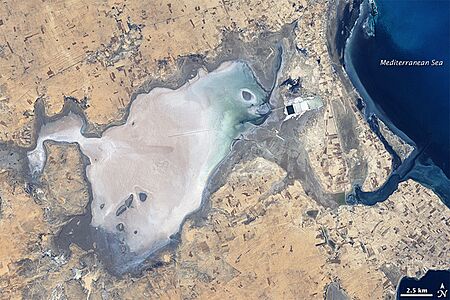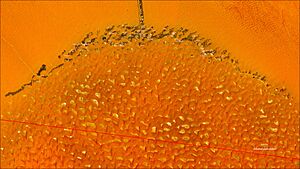Sabkha facts for kids
A sabkha (pronounced sahb-kha) is a special kind of flat land, often found near coasts in very dry places. Imagine a huge, flat area of mud or sand where lots of salt and other minerals build up. This happens because the climate is so dry that water evaporates quickly, leaving the minerals behind.
Sabkhas are usually found just above the normal high-tide line, acting like a bridge between the land and the sea. You can find these salty flats along many coastlines today. A famous place to see sabkhas is along the southern coast of the Persian Gulf in the United Arab Emirates.
The word "sabkha" comes from an Arabic word meaning "salt flat." Sometimes, these areas are also called sabkhah, sebkha, or coastal sabkha. When these salty flats are found deep inside deserts, away from the coast, they are called continental sabkhas.
Contents
How Sabkhas Form
Coastal Sabkhas: The Abu Dhabi Example
Let's look at how coastal sabkhas form, like those in Abu Dhabi along the Persian Gulf. This area has shallow waters and a very dry climate. The tides are small, and there aren't many big waves. This means the water moves slowly.
A lot of water evaporates here, making the remaining water very salty. In some lagoons, the water can become twice as salty as the open ocean! Islands and peninsulas protect these coastal areas, helping the sabkhas to grow.
Underground water, called groundwater, is super important for sabkhas. This water slowly rises to the surface. But instead of forming a pond, it evaporates right away because of the hot, dry air. This leaves behind layers of salt. Imagine a sponge soaking up water, and the water slowly moving to the top. That's a bit like how groundwater reaches the surface through a layer called the capillary fringe.
This process has created a huge salt flat in Abu Dhabi, covering an area of about 36,000 square kilometers (13,900 square miles). The groundwater brings many dissolved minerals to the surface. When the water evaporates, these minerals become very concentrated, much saltier than seawater.
Because these areas are so dry, very few plants can grow. This lack of plants allows the wind to shape the land. The wind can blow away loose sand and mud, but it can't move the wet, salty material below the surface. This means the surface of the sabkha often looks like the level of the underground water. Over time, all this evaporation creates vast, flat areas covered in salty crusts.
From Lagoons to Salt Flats
Another way sabkhas form is through a process called the khor-lagoon-sabkha model. Imagine the sea level rising and flooding low-lying coastal areas. This creates shallow water channels called khors. These khors are like small, calm inlets. If fresh water from rivers or underground sources mixes in, you might even see mangrove trees growing there.
Over time, mud and sand build up in these khors, making them shallower. They slowly turn into lagoons, which are calm, shallow pools of water. These lagoons continue to fill with sediment until their bottoms are exposed during low tide. This is when a sabkha starts to form!
Sometimes, very high tides, heavy rain, or strong winds can push seawater back onto the sabkha, covering it with a thin layer of water. But eventually, this water evaporates, leaving more salt behind. Over many years, these sabkhas can grow and join together to form huge, flat coastal plains. These plains are incredibly flat, with only small changes in height.
Often, you'll find these sabkhas protected from the open ocean by natural barriers like coral reefs or barrier islands. These barriers create calm conditions, perfect for mangroves and tiny plant mats to grow. Inland from these protected areas, the sabkhas stretch out, sometimes for many kilometers.
Sabkhas in Dune Deserts
Sabkhas can also form in deserts where there are many sand dunes. When it rains, water collects in the low areas between the dunes, forming temporary pools. These pools can also be fed by underground water sources.
A great example is the Empty Quarter desert in Saudi Arabia and the southern United Arab Emirates. Here, you'll see tall, moving sand dunes next to flat, salty areas – these are continental sabkhas. Sometimes, these sabkhas connect, creating long, flat paths through the desert.
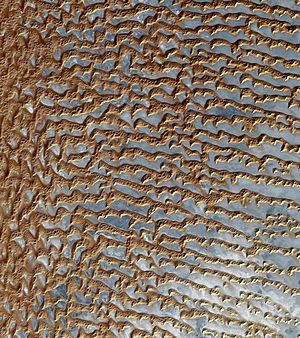
Dunes and salt flats in the Empty Quarter
|
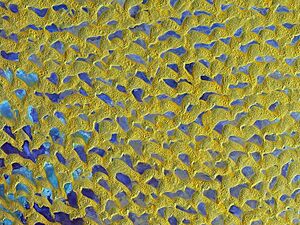
Dunes and salt flats in the Empty Quarter
|
The third picture shows an area south of the crescent-shaped Liwa Oasis in the southern UAE. It's about 80 kilometers (50 miles) wide. Each continental sabkha here is about 2-3 kilometers (1-2 miles) long and 1 kilometer (0.6 miles) wide. White salt covers the surface. The Moreeb Dune, which is 120 meters (390 feet) tall, stands in the middle of this picture. The border between Saudi Arabia and the UAE is shown in red.
The ground of a dry continental sabkha is usually a hard mix of sand, mud, and salt. It is easy to walk or drive 4x4 vehicles across. However, after rains and flash-floods, the continental sabkhas fill with shallow water. They cannot be crossed until they dry out and form a new crust. When the ground is partly dried, a salt crust forms over soft mud. If a vehicle breaks through this crust, it can get stuck!
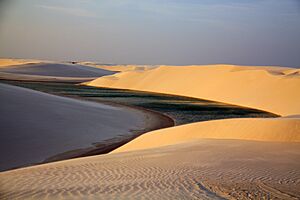
Flooded dune field in the Lençóis Maranhenses National Park (Brazil).
|
How Climate Shapes Sabkhas
The climate is a major reason why sabkhas look the way they do. In these dry regions, rain usually comes as thunderstorms, averaging only about 4 centimeters (1.6 inches) per year. Temperatures can be very hot, over 50°C (122°F), or drop to 0°C (32°F).
Humidity changes with the wind. It can be very dry in the mornings, but get very humid in the afternoon when winds blow from the sea. At night, thick fogs can form. Water in shallow areas can be much warmer than deeper water. These high temperatures cause a lot of water to evaporate from the Persian Gulf, making the shallow lagoons very salty.
Even though a lot of water evaporates, underground water keeps flowing towards the sea. This water is refilled by rainstorms and strong winds that push seawater inland. These climate changes make sabkhas very dynamic, meaning they are always changing.
Different minerals are deposited on the sabkha surface and just below it. For example, halite (table salt) forms on the surface. Other minerals like gypsum and aragonite grow underground as salty water rises and evaporates. In very dry parts, gypsum can change into anhydrite. These minerals can form interesting patterns, like polygonal shapes on the surface.
Sabkhas and Energy Resources
Sabkha deposits are important because they are believed to hold some of the world's major underground oil and gas reserves, especially in the Middle East. The tiny plants and ancient mangrove soils found in sabkha layers might be the source of these hydrocarbons (oil and gas).
Similar ancient sabkha deposits are found in many places, like the Permian Basin in Texas and the Gulf of Mexico. Today, sabkhas can be seen along the coasts of North Africa, Baja California, and at Shark Bay in Australia.
Building on Sabkha Land
Building on sabkha land can be tricky for engineers. Sabkha soils are often weak because the concentrated salt solutions in the water can make the soil structure less stable. Also, the extreme weather, with big temperature changes and cycles of getting wet and dry, can make the soil unstable. Some minerals that act like glue in the soil can dissolve easily, which weakens the ground.
Coastal sabkhas are mostly made of minerals like calcite, dolomite, and gypsum. They also have smaller amounts of anhydrite, magnesite, and halite (salt). The underground water in these areas is very salty, with high levels of sodium chloride (table salt), which can cause corrosion to building materials.
Inland sabkhas, however, can have a wider variety of minerals. The types of minerals found depend on the specific makeup of the local underground water. So, the ground in these desert sabkhas can be very different from coastal ones. Engineers use special methods, like compacting the soil, to make sabkha land strong enough for construction.
See also
- Badain Jaran Desert
- Chott el Hodna
- Garabogazköl
- Lençóis Maranhenses National Park
- Sabkhat Matti
- Salt pan


